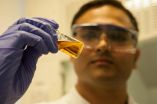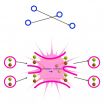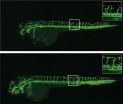Boosting gas mileage by turning engine heat into electricity
2015-07-22
(Press-News.org) Automakers are looking for ways to improve their fleets' average fuel efficiency, and scientists may have a new way to help them. In a report in the journal ACS Applied Materials & Interfaces, one team reports the development of a material that could convert engine heat that's otherwise wasted into electrical energy to help keep a car running -- and reduce the need for fuels. It could also have applications in aerospace, manufacturing and other sectors.
In 2012, the Obama administration announced fuel-efficiency standards that would require U.S. vehicles to average 54.5 miles per gallon by 2025. Improving gas mileage could help reduce greenhouse gas emissions and global dependence on fossil fuels. One approach scientists are exploring to help address these issues involves capturing waste heat from engines and other power systems and turning it into electricity. Many compounds can do this but are heavy, costly, toxic or only operate at high temperatures. Ian A. Kinloch, Robert Freer and colleagues sought new alternatives.
The researchers started with a material called strontium titanium dioxide and added a small amount of graphene, a stable material with excellent conductive properties. The resulting composite was able to capture and convert heat into electric current efficiently over a broad temperature range.
INFORMATION:
The authors acknowledge funding from the University of Manchester Intellectual Property, Engineering and Physical Sciences Research Council and the European Union Seventh Framework Programme.
The American Chemical Society is a nonprofit organization chartered by the U.S. Congress. With more than 158,000 members, ACS is the world's largest scientific society and a global leader in providing access to chemistry-related research through its multiple databases, peer-reviewed journals and scientific conferences. Its main offices are in Washington, D.C., and Columbus, Ohio.
To automatically receive news releases from the American Chemical Society, contact newsroom@acs.org.
Follow us: Twitter Facebook END
ELSE PRESS RELEASES FROM THIS DATE:
2015-07-22
Lithium-ion batteries remain the technology-of-choice for today's crop of electric cars, but challengers are revving up to try to upset the current order. An article in Chemical & Engineering News (C&EN), the weekly newsmagazine of the American Chemical Society, takes a look at two of the top contenders vying to erode lithium-ion's dominance.
Alex Scott, a senior editor at C&EN, reports on two developments from companies in England that seem poised to compete in the electric car battery market within the next two to four years. One is a sodium-ion version, produced by ...
2015-07-22
If you experience a major heart attack the damage could cost you around five billion heart cells. Future stem cell treatments will require this number and more to ensure those cells are replaced and improve your chances of survival.
Experts at The University of Nottingham have discovered the first fully synthetic substrate with potential to grow billions of stem cells. The research, published in the academic journal Advanced Materials, could forge the way for the creation of 'stem cell factories' - the mass production of human embryonic (pluripotent) stem cells.
The ...
2015-07-22
Canada has almost eliminated mother-to-child HIV transmission, known as vertical transmission, in recent years by ensuring that all women have the opportunity to be screened for HIV in pregnancy and that women with the disease receive treatment before giving birth.
In 2014, there was only one recorded transmission of the virus to babies born to women known to be living with HIV.
These findings were presented at the International AIDS Society 2015 conference in Vancouver by researchers from the Canadian Perinatal HIV Surveillance Program (CPHSP), a national group that ...
2015-07-22
SALT LAKE CITY- As part of a multi-institutional effort, researchers with Huntsman Cancer Institute at the University of Utah have found that multiple myeloma patients with a genetic variation in the gene FOPNL die on average 1-3 years sooner than patients without it. The finding was identified with a genetic mapping technique, genome wide association studies (GWAS), and verified in patient populations from North America and Europe. This was the first study to survey the entire human genome for genetic variation influencing survival, and included a total of 1,635 patients.
Published ...
2015-07-22
A test of the Mobile Bridge® Version 4.0 (MB4.0) over a real river demonstrated its viability for practical use. During the test, the bridge was set up without any foundation work, and a vehicle could easily travel across it. This was achieved safely with very few people and without any problems. The MB4.0 viability test results were presented at a symposium of the Japan Society of Civil Engineers (JSCE) on June 23, 2015, by Dr. Ichiro Ario, Assistant Professor at the Institute of Engineering, Hiroshima University.
Background of developing MB:
Natural disasters include ...
2015-07-22
A new theory says dark matter acts remarkably similar to subatomic particles known to science since the 1930s.
We owe a lot to dark matter - it is the thing keeping galaxies, stars, our solar system, and our bodies intact. Yet no one has been able to observe it, and it has often been regarded as a totally new exotic form of matter, such as a particle moving in extra dimensions of space or its quantum version, super-symmetry.
Now an international group of researchers has proposed a theory that dark matter is very similar to pions, which are responsible for binding atomic ...
2015-07-22
Bethesda, MD (July 22, 2015) -- Newborn children born with a mutation in the Plasmalemma Vesicle Associated Protein (PLVAP) gene develop severe protein losing enteropathy, according to a case study1 published in Cellular and Molecular Gastroenterology and Hepatology, the basic science journal of the American Gastroenterological Association. Protein losing enteropathy is a condition of the GI tract that results in loss of protein from the body, and often leads to severe abdominal swelling, malnutrition and early death in affected infants
The investigators utilized next-generation ...
2015-07-22
This news release is available in German.
New methods for modifying the genome are currently widely discussed: Using CRISPR/Cas for instance, scientists can remove parts of the genetic code of a gene, thereby knocking it out. Furthermore, there are ways to inhibit translation of a gene into a protein. Both methods have in common that they impede production of a protein and should therefore have comparable consequences for an organism. However, it has been shown that consequences can differ, after a gene is either knocked, out or only blocked. Scientist from the ...
2015-07-22
Levels of biomarkers in the blood of pregnant women can be used to predict which women are at risk of pre-eclampsia, finds a study published today (22 July) in BJOG: An International Journal of Obstetrics and Gynaecology (BJOG). ADMA and Hcy, both known to be raised in women with pre-eclampsia, are present in the blood in higher than normal concentrations a month before the onset of the condition.
Pre-eclampsia is a combination of raised blood pressure (hypertension) and protein in the urine (proteinuria). It is quite common, usually occurring after 20 weeks of pregnancy, ...
2015-07-22
Scientists at Lawson Health Research Institute have uncovered an important new target for ovarian cancer therapy. Contrary to current research this new study found that LKB1, a molecule that regulates the metabolism of many adult cells, is an important molecule in the cancer's promotion and survival.
Thousands of women are living with ovarian cancer in Canada. It is estimated that this year, 2,800 Canadian women will be newly diagnosed with this disease. Even though ovarian cancer continues to be one of the most serious women's cancers, there is a real lack in reliable ...
LAST 30 PRESS RELEASES:
[Press-News.org] Boosting gas mileage by turning engine heat into electricity



